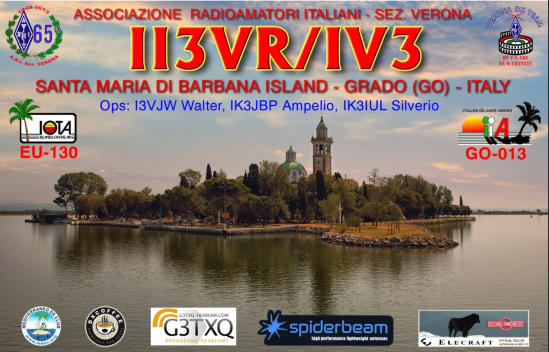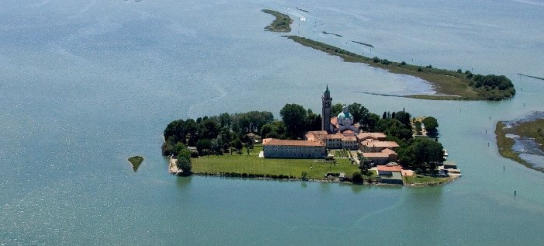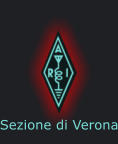










II3VR/IV3
ATTIVAZIONE ISOLA DI SANTA MARIA DI BARBANA
IOTA EU-130 IIA GO-013
27-28 luglio 2013
Log online con OQRS su ClubLog
In occasione del 65° anniversario della Sezione ARI di Verona l'ARI VERONA DX TEAM è
lieta di comunicare che, in occasione del Contest IOTA 2013 del 27-28 Luglio, attiverà l'Isola
di Santa Maria di Barbana IOTA EU-130, IIA GO-013. L'isola è situata a circa 30 minuti di
imbarcazione dal porto di Grado (GO). E' la sede di un monastero dell'Ordine dei Frati Minori.
Grazie alla fattiva collaborazione di padre Gianfranco J52OFM (one of J52EME/HF) abbiamo
ottenuto l'autorizzazione per poter operare per 24 ore in radio in occasione del Contest IOTA
2013.
II3VR/IV3 sarà il nominativo che useremo e gli operatori saranno I3VJW Walter, IK3JBP
Ampelio e IK3IUL Silverio.
Saremo attivi su tutte le bande operative del contest sia in CW che SSB nella categoria: Multi-
Single All Mode 24 Hours. Inoltre, sia nel periodo pre-contest che post-contest, per alcune
ore, saremo operativi nelle bande WARC.
Il setup della stazione II3VR/IV3 sarà il seguente:
RXTX: Icom 756 Pro II - Kenwood TS-590s
Power Ampl.: Elecraft KPA500
Antenne: HexBeam 6 bande di G3TXQ prodotta da MW0JZE - Vert. Monopole Spiderbeam
18mt full-size (80mt) - Vert. Monopole Spiderbeam 12mt full-size (40mt)
N.1 pc portatile e interfaccie varie.
Cogliamo l'occasione per ringraziare L'Ordine dei Frati Minori con padre Gianfranco per il
supporto logistico, IK3ESB Tony per la preparazione dei materiali tecnici, I3EJ Renato per la
parte riguardante le informazioni sul sito web, IK3MZS Andrea per le magliette "Polo"
personalizzate.
QSL via IQ3VO diretta o via bureau (vedi II3VR e qrz.com)
ARI VERONA DX TEAM
L’ ISOLA DI SANTA MARIA DI BARBANA
Santa Maria di Barbana, Friuli IOTA: EU-130 - IIA: GO-013
Barbana è un'isola posta all'estremità orientale della laguna di Grado, sede di un antico
santuario mariano.
Si estende su circa tre ettari e dista circa cinque chilometri da Grado; è abitata in modo stabile
da una comunità di frati minori francescani.
Il suo nome deriva probabilmente da Barbano, un eremita del VI secolo che viveva nel luogo
e che raccolse attorno a sé una comunità di monaci.
Le origini dell'isola sono relativamente recenti: la laguna di Grado si è infatti formata tra il V e
il VII secolo su di un'area precedentemente occupata dalla terraferma. Il luogo ospitava, in
epoca romana, un tempio di Apollo Beleno e, probabilmente, l'area destinata alla quarantena
del vicino porto di Aquileia.
Un piccolo bosco si estende sul lato occidentale dell'isola e ne copre più della metà della
superficie: le essenze più diffuse sono i bagolari, i pini marittimi, le magnolie, i cipressi, gli
olmi.
L'isola di Barbana è collegata a Grado da un regolare servizio di traghetti, con partenza dal
Canale della Schiusa. Il viaggio richiede circa 20 minuti di navigazione. L'isola è inoltre dotata
di un piccolo porto e può essere raggiunta anche con mezzi privati.
Storia
Secondo la tradizione, la nascita del santuario della Madonna di Barbana risale all’anno 582,
quando una violenta mareggiata minacciò la città di Grado: l'eccezionale evento
meteorologico, che allora destò grande stupore e preoccupazione, si inserisce probabilmente
nella genesi dell'attuale laguna. Al termine della tempesta un'immagine della Madonna,
trasportata dalle acque, venne ritrovata ai piedi di un olmo (o, secondo un'altra tradizione, sui
suoi rami), nei pressi delle capanne di due eremiti originari del trevisano, Barbano e Tarilesso.
Il luogo era allora relativamente lontano dalla linea di costa e il patriarca di Grado Elia (571-
588), come ringraziamento alla Madonna per aver salvato la città dalla mareggiata, fece
erigere una prima chiesa.
Attorno a Barbano si formò una prima comunità di monaci (i "barbaniti") che resse il santuario
per i successivi quattro secoli. In questo arco di tempo il mare proseguì la sua avanzata: nel
734, da un documento di papa Gregorio III, si apprende infatti che Barbana era già un'isola.
La chiesa venne probabilmente ricostruita più volte e la stessa immagine della Madonna, non
si sa se una statua o un'icona, andò perduta.
Attorno all'anno mille, ai barbaniti subentrarono i benedettini che ufficiarono il santuario per
cinquecento anni. A questo periodo risale la pestilenza che investì Grado nel 1237 e l'origine
del pellegrinaggio annuale della città a Barbana.
Dal 1450 è documentata la presenza di frati francescani conventuali, che sostituirono i
benedettini prima in chiave provvisoria e poi, dal 1619, in modo definitivo. I francescani, che
nel 1738 eressero una nuova chiesa a tre navate, rimasero nell'isola fino al 1769, quando la
Repubblica di Venezia soppresse il monastero.
I legami di Venezia con il santuario, a dispetto di questo provvedimento, furono comunque
sempre intensi, com'è testimoniato da lasciti testamentari di dogi (Pietro Ziani, 1228[1]) e
dall'esistenza, in passato, di un'apposita confraternita di gondolieri (la "Fratellanza della Beata
Vergine di Barbana"). Lo stesso bassorilievo dell'altare maggiore della chiesa di Barbana
rappresenta, non a caso, una gondola in laguna.
Dopo l'allontanamento dei frati, il santuario venne quindi affidato per oltre 130 anni ai
sacerdoti diocesani, prima di Udine (1769-1818), poi di Gorizia (1818-1901). Un ruolo di
particolare rilievo venne svolto da don Leonardo Stagni, al quale si devono la costruzione
degli argini (1851), la realizzazione dell'attuale cappella del bosco nel luogo dove venne
ritrovata l'immagine di Maria (1854) e l'incoronazione della Madonna di Barbana (1863).
Nel 1901 il santuario venne affidato ai frati francescani minori della provincia dalmata che
edificarono un nuovo convento, curarono alcune bonifiche e misero mano alla costruzione
dell'attuale chiesa. Nel 1924, mutati i confini politici, il testimone passò ai confratelli della
provincia veneta di San Francesco, che hanno provveduto alla realizzazione della casa di
esercizi spirituali "Domus Mariae" (1959) e delle più recenti casa del pellegrino (1980) e
cappella della riconciliazione (1989).
II3VR/IV3
ACTIVATION OF “SANTA MARIA DI BARBANA” ISLAND
IOTA EU-130 IIA GO-013
27-28 July, 2013
Log online with OQRS on ClubLog
On the occasion of the 65th anniversary of the founding of the Verona Section of ARI, the ARI
VERONA DX TEAM is pleased to announce that during the IOTA Contest 2013 (July 27 to
28) will activate the Island of "Santa Maria di Barbana" IOTA EU-130 IIA GO -013.
The Island is located about 30 minutes by boat from the port of Grado (Gorizia). It's the site of
a Monastery of the Order of Friars Minor.
Thanks to the collaboration of Father Gianfranco J52OFM (one of J52EME-J52HF), we got
authorization to operate 48 hours during the IOTA Contest 2013.
II3VR/IV3 will be the call used. The operators will be I3VJW Walter, IK3JBP Ampelio and
IK3IUL Silverio.
We'll be active on all the contest bands, operating both CW and SSB, in the category: Multi-
Single All Mode 24 Hours.
Moreover, both in the pre-contest and post-contest, for a few hours, we'll be operating on the
WARC bands.
Set-up of II3VR/IV3 station:
TXRX: ICOM 756 PROII - KENWOOD TS950S
Power Amplifier: ELECRAFT KPA500
Antennas: HEXBEAM 6 band by G3TXQ produced by MW0JZE - Vertical Monopole 18mt
SPIDERBEAM for 80mt full-size - Vertical Monopole 12mt SPIDERBEAM for 40mt full-size.
Many thanks to The Order of Minor Friars, Father Gianfranco for logistic support, IK3ESB
Tony for the preparation of technical materials, I3EJ Renato for the part concerning the
information on the website, Andrea IK3MZS for personalized t-shirts.
QSL via IQ3VO direct or via bureau (see II3VR and qrz.com)
VERONA DX TEAM
ISLAND OF SANTA MARIA DI BARBANA
Santa Maria di Barbana, Friuli IOTA: EU-130 - IIA: GO-013
Barban is an island situated at the eastern end of the lagoon of Grado, site of an ancient
shrine.
It covers about three acres and is approximately five miles from Grado, is inhabited
permanently by a community of Franciscan friars.
Its name probably derives from Barbano, a sixth century hermit who lived in the place and
gathered around himself a community of monks.
The origins of the island are relatively recent: the lagoon of Grado is indeed formed between
the V and VII century on an area previously occupied by the mainland. The place housed in
Roman times, a temple of Apollo Belen and probably destined for a quarantine of the area
near the port of Aquileia.
A small forest stretches on the western side of the island and covers more than half of the
surface: the essences are the most common hackberry trees, maritime pines, magnolias,
cypress, elm trees.
The island is connected to Barban Degree from a regular ferry service, departing from the
Channel Hatching. The journey takes about 20 minutes by boat. The island also has a small
port and can also be reached by private vehicles.
History
According to tradition, the birth of the shrine of Our Lady of Barban dates from the year 582,
when a violent storm threatened the town of Grado: the exceptional weather event, which then
aroused astonishment and concern, it probably fits in the genesis of the lagoon. At the end of
the storm image of the Madonna, transported by water, was found at the foot of an elm (or,
according to another tradition, on its branches), near the huts of two hermits originating in
Treviso, Barbano and Tarilesso. The place was then relatively far away from the coastline and
the patriarch of Grado Elia (571-588), as a thanksgiving to the Virgin Mary for having saved
the city by storm, he built the first church.
Around Barbano formed the first community of monks (the "Barbaniti") who ruled the
sanctuary for the next four centuries. In this period, the sea continued its advance: in 734, a
document of Pope Gregory III, we learn that in fact Barban was already an island. The church
was probably rebuilt several times and the same image of the Madonna, it is unknown
whether a statue or an icon, was lost.
Around the year one thousand, to Barbaniti were replaced by the Benedictine ufficiarono the
sanctuary for five years. From this period dates the plague that swept Degree in 1237 and the
origin of the pilgrimage to the city's annual Barban.
Since 1450 has documented the presence of the Conventual Franciscans, Benedictines, who
replaced the first key in the interim and then, since 1619, in a definitive way. The Franciscans,
who in 1738 built a new church with three naves, remained on the island until 1769, when the
Republic of Venice suppressed the monastery.
The ties of Venice with the sanctuary, in spite of this measure, however, were always intense,
as evidenced by legacies of the Doges (Pietro Ziani, 1228 ) and the existence in the past of a
special brotherhood of Gondoliers (the "Brotherhood of Our Lady of Barban"). The same bas-
relief of the high altar of the church of Barban is, not surprisingly, a gondola in the lagoon.
After the removal of the friars, the sanctuary was then entrusted to the diocesan priests over
130 years, before Udine (1769-1818), then of Gorizia (1818-1901). A particularly important
role was played by Don Leonardo Ponds, who was responsible for the construction of
embankments (1851), the construction of the chapel in the place where the forest was found
the image of Mary (1854) and the coronation of Our Lady of Barban (1863).
In 1901 the sanctuary was entrusted to the Franciscan Friars Minor of the Province Dalmatian,
who built a new convent, cured number of land reclamation and put into the building of the
present church. In 1924, changed the political boundaries, the baton was passed to the
brothers of the Venetian province of San Francesco, which have already been done: the
retreat house "Domus Mariae" (1959) and the most recent Pilgrim's House (1980) and the
Chapel of Reconciliation (1989).










